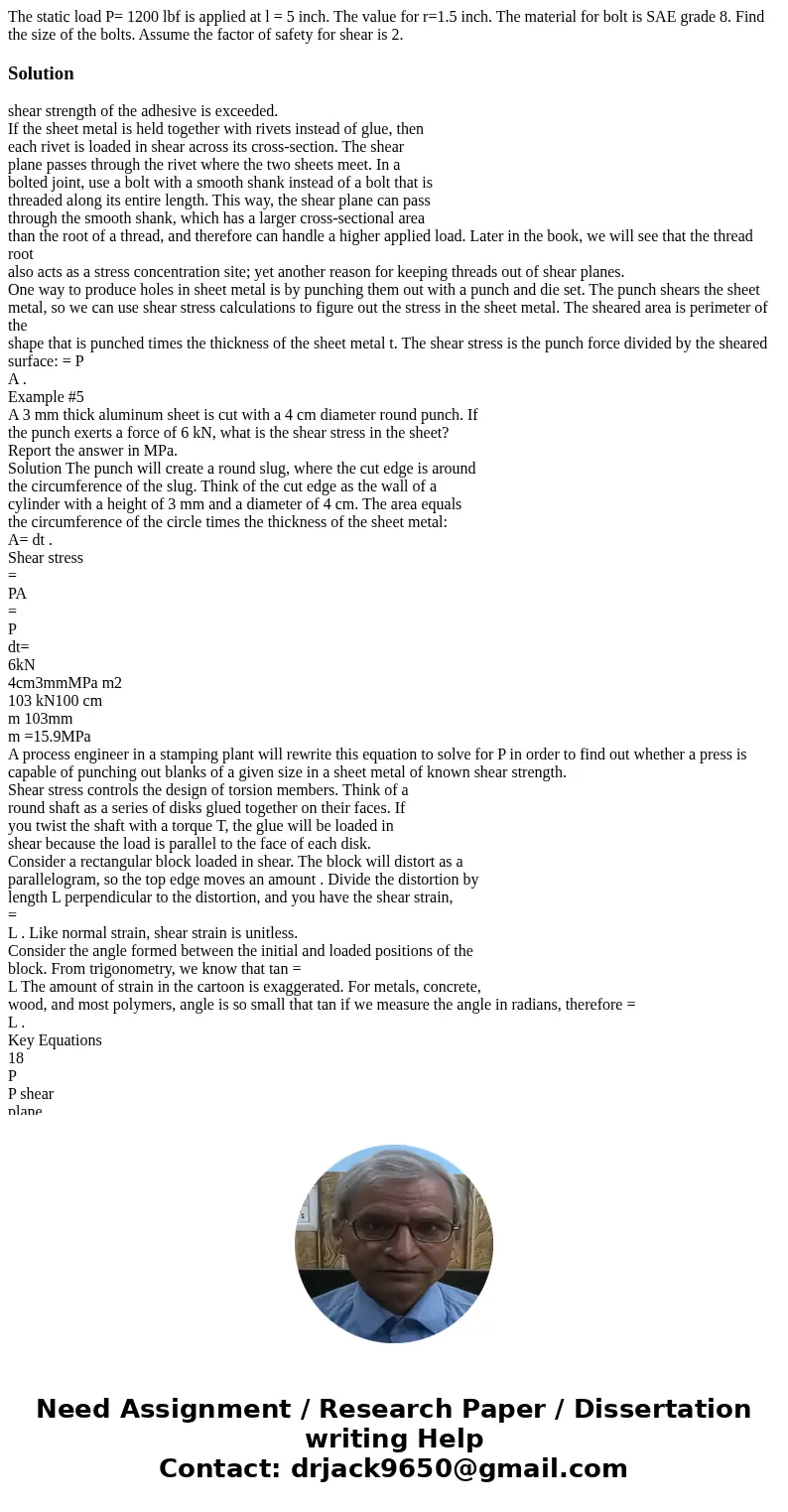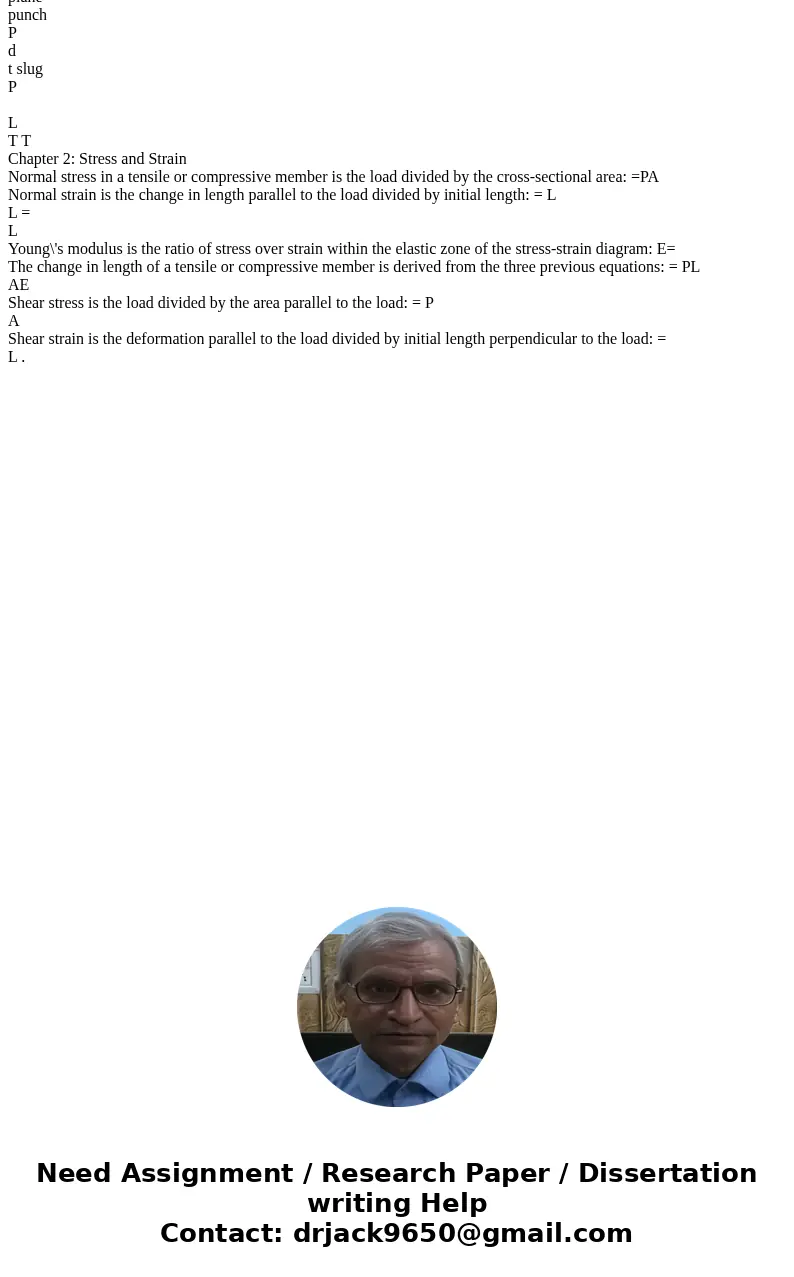The static load P 1200 lbf is applied at l 5 inch The value
The static load P= 1200 lbf is applied at l = 5 inch. The value for r=1.5 inch. The material for bolt is SAE grade 8. Find the size of the bolts. Assume the factor of safety for shear is 2.
Solution
shear strength of the adhesive is exceeded.
If the sheet metal is held together with rivets instead of glue, then
each rivet is loaded in shear across its cross-section. The shear
plane passes through the rivet where the two sheets meet. In a
bolted joint, use a bolt with a smooth shank instead of a bolt that is
threaded along its entire length. This way, the shear plane can pass
through the smooth shank, which has a larger cross-sectional area
than the root of a thread, and therefore can handle a higher applied load. Later in the book, we will see that the thread root
also acts as a stress concentration site; yet another reason for keeping threads out of shear planes.
One way to produce holes in sheet metal is by punching them out with a punch and die set. The punch shears the sheet
metal, so we can use shear stress calculations to figure out the stress in the sheet metal. The sheared area is perimeter of the
shape that is punched times the thickness of the sheet metal t. The shear stress is the punch force divided by the sheared
surface: = P
A .
Example #5
A 3 mm thick aluminum sheet is cut with a 4 cm diameter round punch. If
the punch exerts a force of 6 kN, what is the shear stress in the sheet?
Report the answer in MPa.
Solution The punch will create a round slug, where the cut edge is around
the circumference of the slug. Think of the cut edge as the wall of a
cylinder with a height of 3 mm and a diameter of 4 cm. The area equals
the circumference of the circle times the thickness of the sheet metal:
A= dt .
Shear stress
=
PA
=
P
dt=
6kN
4cm3mmMPa m2
103 kN100 cm
m 103mm
m =15.9MPa
A process engineer in a stamping plant will rewrite this equation to solve for P in order to find out whether a press is
capable of punching out blanks of a given size in a sheet metal of known shear strength.
Shear stress controls the design of torsion members. Think of a
round shaft as a series of disks glued together on their faces. If
you twist the shaft with a torque T, the glue will be loaded in
shear because the load is parallel to the face of each disk.
Consider a rectangular block loaded in shear. The block will distort as a
parallelogram, so the top edge moves an amount . Divide the distortion by
length L perpendicular to the distortion, and you have the shear strain,
=
L . Like normal strain, shear strain is unitless.
Consider the angle formed between the initial and loaded positions of the
block. From trigonometry, we know that tan =
L The amount of strain in the cartoon is exaggerated. For metals, concrete,
wood, and most polymers, angle is so small that tan if we measure the angle in radians, therefore =
L .
Key Equations
18
P
P shear
plane
punch
P
d
t slug
P
L
T T
Chapter 2: Stress and Strain
Normal stress in a tensile or compressive member is the load divided by the cross-sectional area: =PA
Normal strain is the change in length parallel to the load divided by initial length: = L
L =
L
Young\'s modulus is the ratio of stress over strain within the elastic zone of the stress-strain diagram: E=
The change in length of a tensile or compressive member is derived from the three previous equations: = PL
AE
Shear stress is the load divided by the area parallel to the load: = P
A
Shear strain is the deformation parallel to the load divided by initial length perpendicular to the load: =
L .


 Homework Sourse
Homework Sourse